Cacao Pod Husk Extract Phenolic Nanopowder-Impregnated Cellulose Acetate Matrix for Biofouling Control in Membranes
Abstract
:1. Introduction
2. Materials and Methods
2.1. Materials
2.2. Preparation of CPHE
2.3. Preparation of CPHE Phenolic Nanopowder/CA Composite Membrane
2.4. Membrane Characterizations
2.5. Pure Water Flux
2.6. Antibiofouling Study
3. Results and Discussion
3.1. CPHE Extract Characteristics
3.2. Composite Membrane Properties
3.3. Membrane Volumetric Transport Assessment
3.4. Antibiofouling Property
4. Conclusions
Author Contributions
Funding
Acknowledgments
Conflicts of Interest
References
- Wibisono, Y.; Bilad, M.R. 3—Design of forward osmosis system. In Current Trends and Future Developments on (Bio-) Membranes; Basile, A., Cassano, A., Rastogi, N.K., Eds.; Elsevier: Amsterdam, The Netherlands, 2020; pp. 57–83. [Google Scholar]
- Wibisono, Y.; Agung Nugroho, W.; Akbar Devianto, L.; Adi Sulianto, A.; Roil Bilad, M. Microalgae in Food-Energy-Water Nexus: A Review on Progress of Forward Osmosis Applications. Membranes 2019, 9, 166. [Google Scholar] [CrossRef] [PubMed] [Green Version]
- Wibisono, Y. Two-Phase Flow for Fouling Control in Membranes; University of Twente: Enschede, The Netherlands, 2014. [Google Scholar]
- Bhattacharjee, C.; Saxena, V.K.; Dutta, S. Fruit juice processing using membrane technology: A review. Innov. Food Sci. Emerg. Technol. 2017, 43, 136–153. [Google Scholar] [CrossRef]
- Baker, J.S.; Dudley, L.Y. Biofouling in membrane systems—A review. Desalination 1998, 118, 81–89. [Google Scholar] [CrossRef]
- Nguyen, T.; Roddick, F.A.; Fan, L. Biofouling of Water Treatment Membranes: A Review of the Underlying Causes, Monitoring Techniques and Control Measures. Membranes 2012, 2, 804–840. [Google Scholar] [CrossRef] [Green Version]
- Lee, S.; Lee, C.H. Scale formation in NF/RO: Mechanism and control. Water Sci. Technol. 2005, 51, 267–275. [Google Scholar] [CrossRef]
- Fan, J.; Zhang, S.; Li, F.; Yang, Y.; Du, M. Recent advances in cellulose-based membranes for their sensing applications. Cellulose 2020, 27, 9157–9179. [Google Scholar] [CrossRef]
- Hodgson, T.D. Selective properties of cellulose acetate membranes towards ions in aqueous solutions. Desalination 1970, 8, 99–138. [Google Scholar] [CrossRef]
- Kamal, H.; Abd-Elrahim, F.M.; Lotfy, S. Characterization and some properties of cellulose acetate-co-polyethylene oxide blends prepared by the use of gamma irradiation. J. Radiat. Res. Appl. Sci. 2014, 7, 146–153. [Google Scholar] [CrossRef]
- Puls, J.; Wilson, S.A.; Hölter, D. Degradation of Cellulose Acetate-Based Materials: A Review. J. Polym. Environ. 2011, 19, 152–165. [Google Scholar] [CrossRef] [Green Version]
- Amiraftabi, M.-S.; Mostoufi, N.; Hosseinzadeh, M.; Mehrnia, M.-R. Reduction of membrane fouling by innovative method (injection of air jet). J. Environ. Health Sci. Eng. 2014, 12, 128. [Google Scholar] [CrossRef] [PubMed] [Green Version]
- Wibisono, Y.; Yandi, W.; Golabi, M.; Nugraha, R.; Cornelissen, E.R.; Kemperman, A.J.B.; Ederth, T.; Nijmeijer, K. Hydrogel-coated feed spacers in two-phase flow cleaning in spiral wound membrane elements: A novel platform for eco-friendly biofouling mitigation. Water Res. 2015, 71, 171–186. [Google Scholar] [CrossRef] [PubMed] [Green Version]
- Sun, X.-F.; Qin, J.; Xia, P.-F.; Guo, B.-B.; Yang, C.-M.; Song, C.; Wang, S.-G. Graphene oxide–silver nanoparticle membrane for biofouling control and water purification. Chem. Eng. J. 2015, 281, 53–59. [Google Scholar] [CrossRef]
- Bucs, S.S.; Linares, R.; Siddiqui, A.; Matin, A.; Khan, Z.; Loosdrecht, M.V.; Yang, R.; Wang, M.; Gleason, K.; Kruithof, J.; et al. Coating of reverse osmosis membranes with amphiphilic copolymers for biofouling control. Desalination Water Treat. 2017, 68, 1–11. [Google Scholar] [CrossRef] [Green Version]
- Tesler, A.B.; Kim, P.; Kolle, S.; Howell, C.; Ahanotu, O.; Aizenberg, J. Extremely durable biofouling-resistant metallic surfaces based on electrodeposited nanoporous tungstite films on steel. Nat. Commun. 2015, 6, 8649. [Google Scholar] [CrossRef]
- Maddox, C.E.; Laur, L.M.; Tian, L. Antibacterial activity of phenolic compounds against the phytopathogen Xylella fastidiosa. Curr. Microbiol. 2010, 60, 53–58. [Google Scholar] [CrossRef] [Green Version]
- Utoro, P.A.R.; Sukoyo, A.; Sandra, S.; Izza, N.; Dewi, S.R.; Wibisono, Y. High-Throughput Microfiltration Membranes with Natural Biofouling Reducer Agent for Food Processing. Processes 2019, 7, 1. [Google Scholar] [CrossRef] [Green Version]
- Lafka, T.-I.; Lazou, A.E.; Sinanoglou, V.J.; Lazos, E.S. Phenolic Extracts from Wild Olive Leaves and Their Potential as Edible Oils Antioxidants. Foods 2013, 2, 18–31. [Google Scholar] [CrossRef]
- Tristantini, D.; Setiawan, H.; Santoso, L.L. Feasibility Assessment of an Encapsulated Longevity Spinach (Gynura procumbens L.) Extract Plant in Indonesia. Appl. Sci. 2021, 11, 4093. [Google Scholar] [CrossRef]
- Vallejo, F.; Marín, J.G.; Tomás-Barberán, F.A. Phenolic compound content of fresh and dried figs (Ficus carica L.). Food Chem. 2012, 130, 485–492. [Google Scholar] [CrossRef]
- Zunjar, V.; Mammen, D.; Trivedi, B.M. Antioxidant activities and phenolics profiling of different parts of Carica papaya by LCMS-MS. Nat. Prod. Res. 2015, 29, 2097–2099. [Google Scholar] [CrossRef]
- Li, T.; Shen, P.; Liu, W.; Liu, C.; Liang, R.; Yan, N.; Chen, J. Major Polyphenolics in Pineapple Peels and their Antioxidant Interactions. Int. J. Food Prop. 2014, 17, 1805–1817. [Google Scholar] [CrossRef]
- Wibisono, Y.; Putri, A.Y.; Dewi, S.R.; Putranto, A.W.; Izza, N. Garlic-based phenolic nanopowder as antibiofouling agent in mixed-matrix membrane. IOP Conf. Series Earth Environ. Sci. 2020, 542, 012005. [Google Scholar] [CrossRef]
- Campos-Vega, R.; Nieto-Figueroa, K.H.; Oomah, B.D. Cocoa (Theobroma cacao L.) pod husk: Renewable source of bioactive compounds. Trends Food Sci. Technol. 2018, 81, 172–184. [Google Scholar] [CrossRef]
- Indonesia, S. Statistik Kakao Indonesia 2019; BPS: Jakarta, Indonesia, 2020. [Google Scholar]
- Donkoh, A.; Atuahene, C.C.; Wilson, B.N.; Adomako, D. Chemical composition of cocoa pod husk and its effect on growth and food efficiency in broiler chicks. Animal Feed Science and Technology 1991, 35, 161–169. [Google Scholar] [CrossRef]
- Karim, A.A.; Azlan, A.; Ismail, A.; Hashim, P.; Abd Gani, S.S.; Zainudin, B.H.; Abdullah, N.A. Phenolic composition, antioxidant, anti-wrinkles and tyrosinase inhibitory activities of cocoa pod extract. BMC Complementary Altern. Med. 2014, 14, 381. [Google Scholar] [CrossRef] [Green Version]
- Mulyatni, A.S.; Budiani, A.; Taniwiryono, D. Antibacterial activity of cocoa pod husk (Theobroma cacao L.) extract againts Escherichia coli, Bacillus subtilis, and Staphylococcus aureus. Menara Perkeb. 2012, 80, 77–84, (In Bahasa Indonesia). [Google Scholar]
- Mu’nisa, A.; Pagarra, H.; Maulana, Z. Active Compounds Extraction of Cocoa Pod Husk (Thebroma Cacaol.) and Potential as Fungicides. J. Phys. Conf. Ser. 2018, 1028, 012013. [Google Scholar] [CrossRef]
- Lu, F.; Rodriguez-Garcia, J.; Van Damme, I.; Westwood, N.J.; Shaw, L.; Robinson, J.S.; Warren, G.; Chatzifragkou, A.; McQueen Mason, S.; Gomez, L.; et al. Valorisation strategies for cocoa pod husk and its fractions. Curr. Opin. Green Sustain. Chem. 2018, 14, 80–88. [Google Scholar] [CrossRef]
- Diniardi, E.M.; Argo, B.D.; Wibisono, Y. Antibacterial activity of cocoa pod husk phenolic extract against Escherichia coli for food processing. IOP Conf. Ser. Earth Environ. Sci. 2020, 475, 012006. [Google Scholar] [CrossRef]
- De Beer, D.; Miller, N.; Joubert, E. Production of dihydrochalcone-rich green rooibos (Aspalathus linearis) extract taking into account seasonal and batch-to-batch variation in phenolic composition of plant material. S. Afr. J. Bot. 2017, 110, 138–143. [Google Scholar] [CrossRef]
- Izza, N.M.; Dewi, S.R.; Setyanda, A.; Sukoyo, A.; Utoro, P.; Al Riza, D.F.; Wibisono, Y. Microwave-assisted extraction of phenolic compounds from Moringa oleifera seed as anti-biofouling agents in membrane processes. MATEC Web Conf. 2018, 204, 03003. [Google Scholar] [CrossRef] [Green Version]
- Wibisono, Y.; Savitri, D.; Dewi, S.R.; Putranto, A.W. Extraction of phenolic compound from garlic (Allium sativum L.) as antibiofuling agent in membranes. J. Ilm. Rekayasa Pertan. Biosist. 2020, 8, 100–109, (In Bahasa Indonesia). [Google Scholar]
- Sánchez-Rangel, J.C.; Benavides, J.; Heredia, J.B.; Cisneros-Zevallos, L.; Jacobo-Velázquez, D.A. The Folin–Ciocalteu assay revisited: Improvement of its specificity for total phenolic content determination. Anal. Methods 2013, 5, 5990–5999. [Google Scholar] [CrossRef]
- Gohari, R.J.; Lau, W.J.; Halakoo, E.; Ismail, A.F.; Korminouri, F.; Matsuura, T.; Jamshidi Gohari, M.S.; Chowdhury, M.N.K. Arsenate removal from contaminated water by a highly adsorptive nanocomposite ultrafiltration membrane. New J. Chem. 2015, 39, 8263–8272. [Google Scholar] [CrossRef]
- Xia, W.; Xie, M.; Feng, X.; Chen, L.; Zhao, Y. Surface Modification of Poly(vinylidene fluoride) Ultrafiltration Membranes with Chitosan for Anti-Fouling and Antibacterial Performance. Macromol. Res. 2018, 26, 1225–1232. [Google Scholar] [CrossRef]
- Pan, Y.; Yu, Z.; Shi, H.; Chen, Q.; Zeng, G.; Di, H.; Ren, X.; He, Y. A novel antifouling and antibacterial surface-functionalized PVDF ultrafiltration membrane via binding Ag/SiO2 nanocomposites. J. Chem. Technol. Biotechnol. 2017, 92, 562–572. [Google Scholar] [CrossRef]
- Mohammadi, T.; Saljoughi, E. Effect of production conditions on morphology and permeability of asymmetric cellulose acetate membranes. Desalination 2009, 243, 1–7. [Google Scholar] [CrossRef]
- Ghazali, A.R.; Inayat-Hussain, S.H. N,N-Dimethylacetamide. In Encyclopedia of Toxicology, 3rd ed.; Wexler, P., Ed.; Academic Press: Oxford, UK, 2014; pp. 594–597. [Google Scholar]
- Bras, J.L.; Muzart, J. N,N-Dimethylformamide and N,N-Dimethylacetamide as Carbon, Hydrogen, Nitrogen, and/or Oxygen Sources. In Solvents as Reagents in Organic Synthesis; Wiley: Hoboken, NJ, USA, 2017; pp. 199–314. [Google Scholar]
- Sobiesiak, M. Chemical Structure of Phenols and Its Consequence for Sorption Processes. In Phenolic Compounds-Natural Sources, Importance and Applications; InTtech Open: Rijeka, Croatia, 2017. [Google Scholar]
- Boussu, K.; Van der Bruggen, B.; Volodin, A.; Snauwaert, J.; Van Haesendonck, C.; Vandecasteele, C. Roughness and hydrophobicity studies of nanofiltration membranes using different modes of AFM. J. Colloid Interface Sci. 2005, 286, 632–638. [Google Scholar] [CrossRef]
- Zafar, M.; Ali, M.; Khan, S.M.; Jamil, T.; Butt, M.T.Z. Effect of additives on the properties and performance of cellulose acetate derivative membranes in the separation of isopropanol/water mixtures. Desalination 2012, 285, 359–365. [Google Scholar] [CrossRef]
- Cuperus, F.P.; Smolders, C.A. Characterization of UF membranes: Membrane characteristics and characterization techniques. Adv. Colloid Interface Sci. 1991, 34, 135–173. [Google Scholar] [CrossRef] [Green Version]
- Hou, T.-P.; Dong, S.-H.; Zheng, L.-Y. The study of mechanism of organic additives action in the polysulfone membrane casting solution. Desalination 1991, 83, 343–360. [Google Scholar] [CrossRef]
- Alvi, M.A.U.R.; Khalid, M.W.; Ahmad, N.M.; Niazi, M.B.K.; Anwar, M.N.; Batool, M.; Cheema, W.; Rafiq, S. Polymer Concentration and Solvent Variation Correlation with the Morphology and Water Filtration Analysis of Polyether Sulfone Microfiltration Membrane. Adv. Polym. Technol. 2019, 2019, 8074626. [Google Scholar] [CrossRef]
- Ahmed, I.; Idris, A.; Hussain, A.; Yusof, Z.A.M.; Saad Khan, M. Influence of Co-Solvent Concentration on the Properties of Dope Solution and Performance of Polyethersulfone Membranes. Chem. Eng. Technol. 2013, 36, 1683–1690. [Google Scholar] [CrossRef]
- Idris, A.; Man, Z.; Maulud, A.S.; Khan, M.S. Effects of Phase Separation Behavior on Morphology and Performance of Polycarbonate Membranes. Membranes 2017, 7, 21. [Google Scholar] [CrossRef] [Green Version]
- Ding, A.; Liang, H.; Li, G.; Szivak, I.; Traber, J.; Pronk, W. A low energy gravity-driven membrane bioreactor system for grey water treatment: Permeability and removal performance of organics. J. Membr. Sci. 2017, 542, 408–417. [Google Scholar] [CrossRef] [Green Version]
- Sabel, A.; Bredefeld, S.; Schlander, M.; Claus, H. Wine Phenolic Compounds: Antimicrobial Properties against Yeasts, Lactic Acid and Acetic Acid Bacteria. Beverages 2017, 3, 29. [Google Scholar] [CrossRef] [Green Version]
- Oliver, S.P.; Gillespie, B.E.; Lewis, M.J.; Ivey, S.J.; Almeida, R.A.; Luther, D.A.; Johnson, D.L.; Lamar, K.C.; Moorehead, H.D.; Dowlen, H.H. Efficacy of a New Premilking Teat Disinfectant Containing a Phenolic Combination for the Prevention of Mastitis. J. Dairy Sci. 2001, 84, 1545–1549. [Google Scholar] [CrossRef]
- Tsui, T.-H.; Ekama, G.A.; Chen, G.-H. Quantitative characterization and analysis of granule transformations: Role of intermittent gas sparging in a super high-rate anaerobic system. Water Res. 2018, 139, 177–186. [Google Scholar] [CrossRef]
- Wibisono, Y.; El Obied, K.E.; Cornelissen, E.R.; Kemperman, A.J.B.; Nijmeijer, K. Biofouling removal in spiral-wound nanofiltration elements using two-phase flow cleaning. J. Membr. Sci. 2015, 475, 131–146. [Google Scholar] [CrossRef]
- Tsui, T.-H.; Chen, L.; Hao, T.; Chen, G.-H. A super high-rate sulfidogenic system for saline sewage treatment. Water Res. 2016, 104, 147–155. [Google Scholar] [CrossRef] [PubMed]
- Zhao, G.; Chen, W.N. Biofouling formation and structure on original and modified PVDF membranes: Role of microbial species and membrane properties. RSC Adv. 2017, 7, 37990–38000. [Google Scholar] [CrossRef] [Green Version]

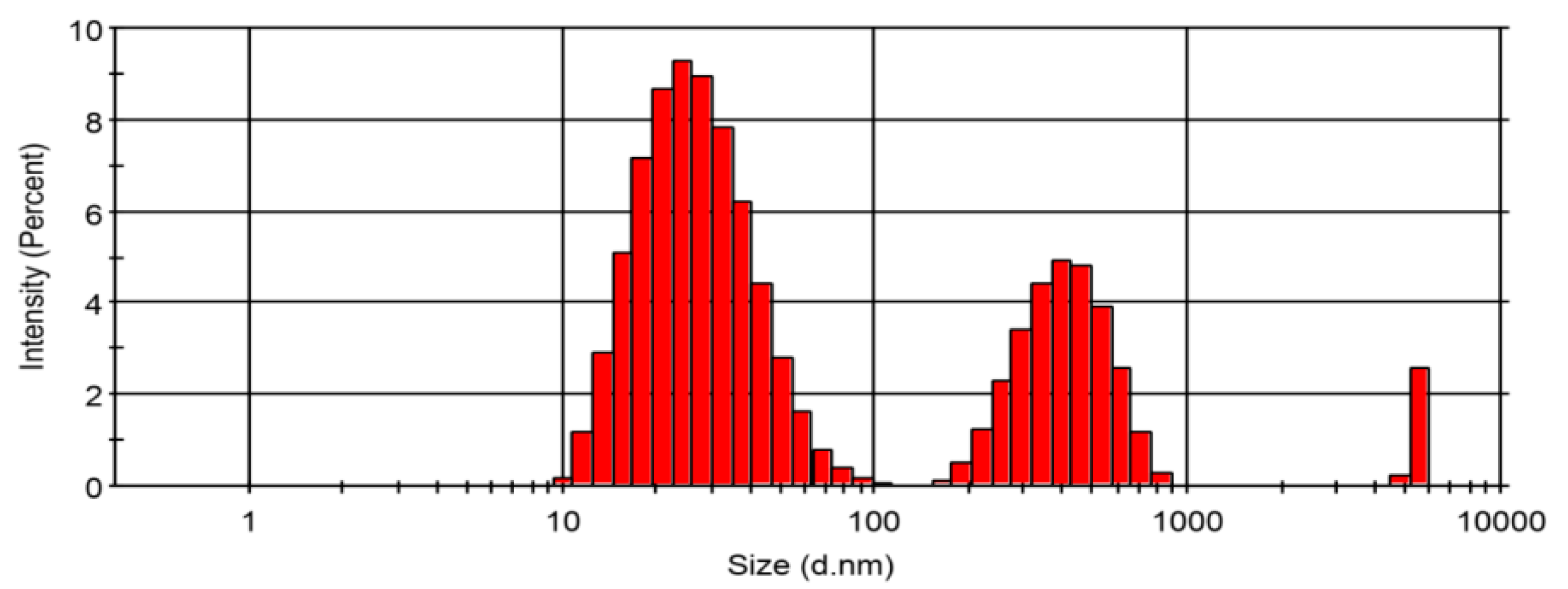
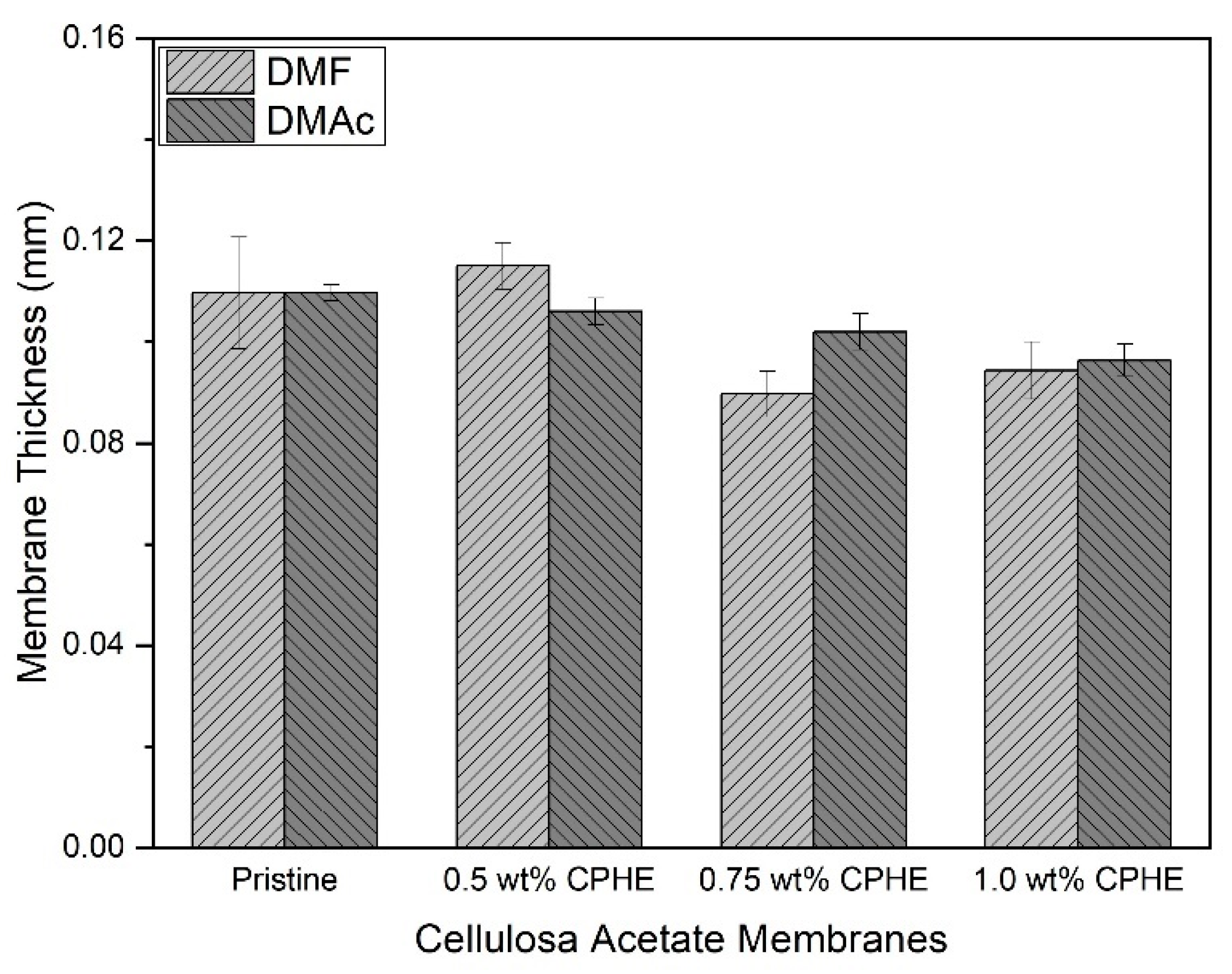
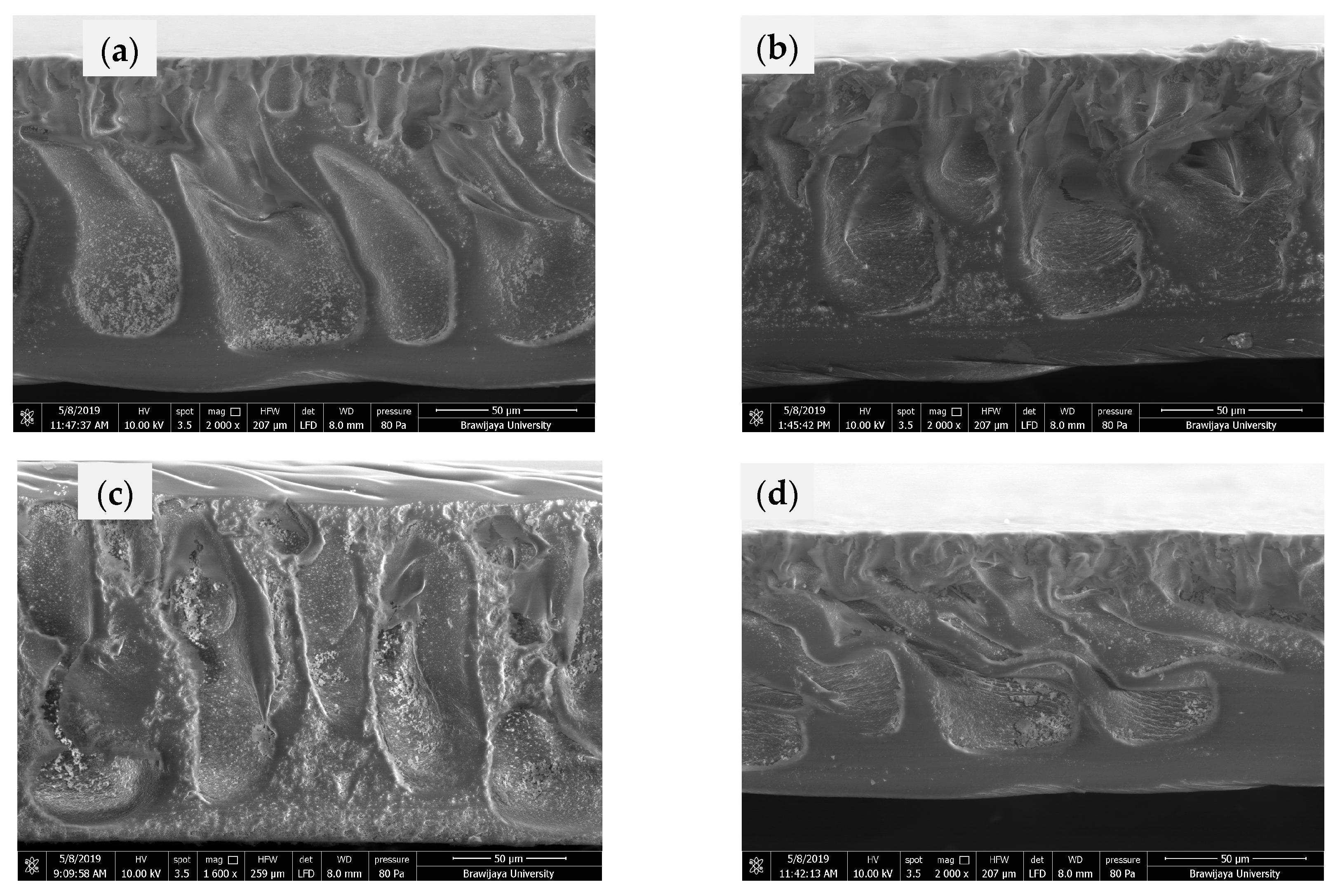

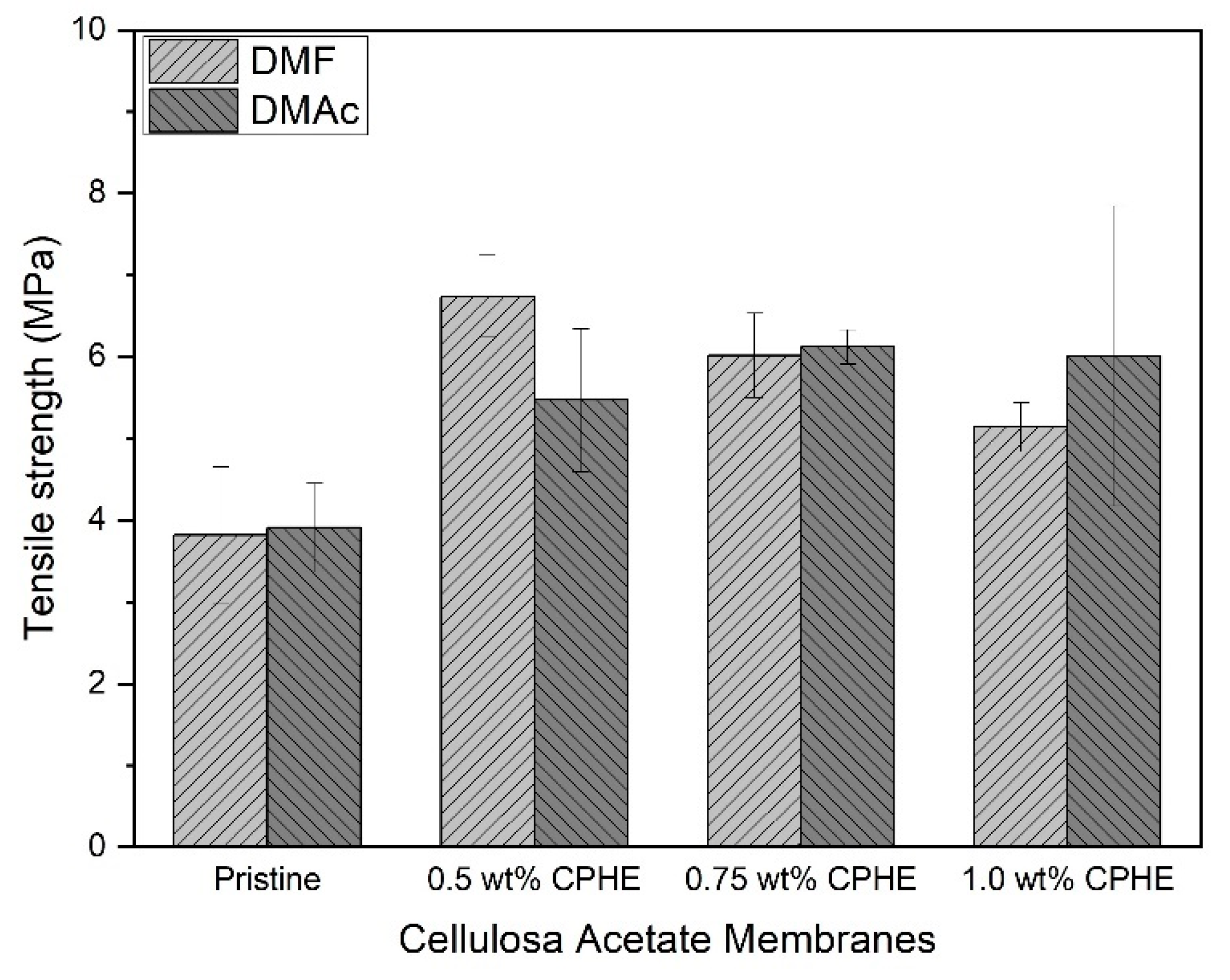
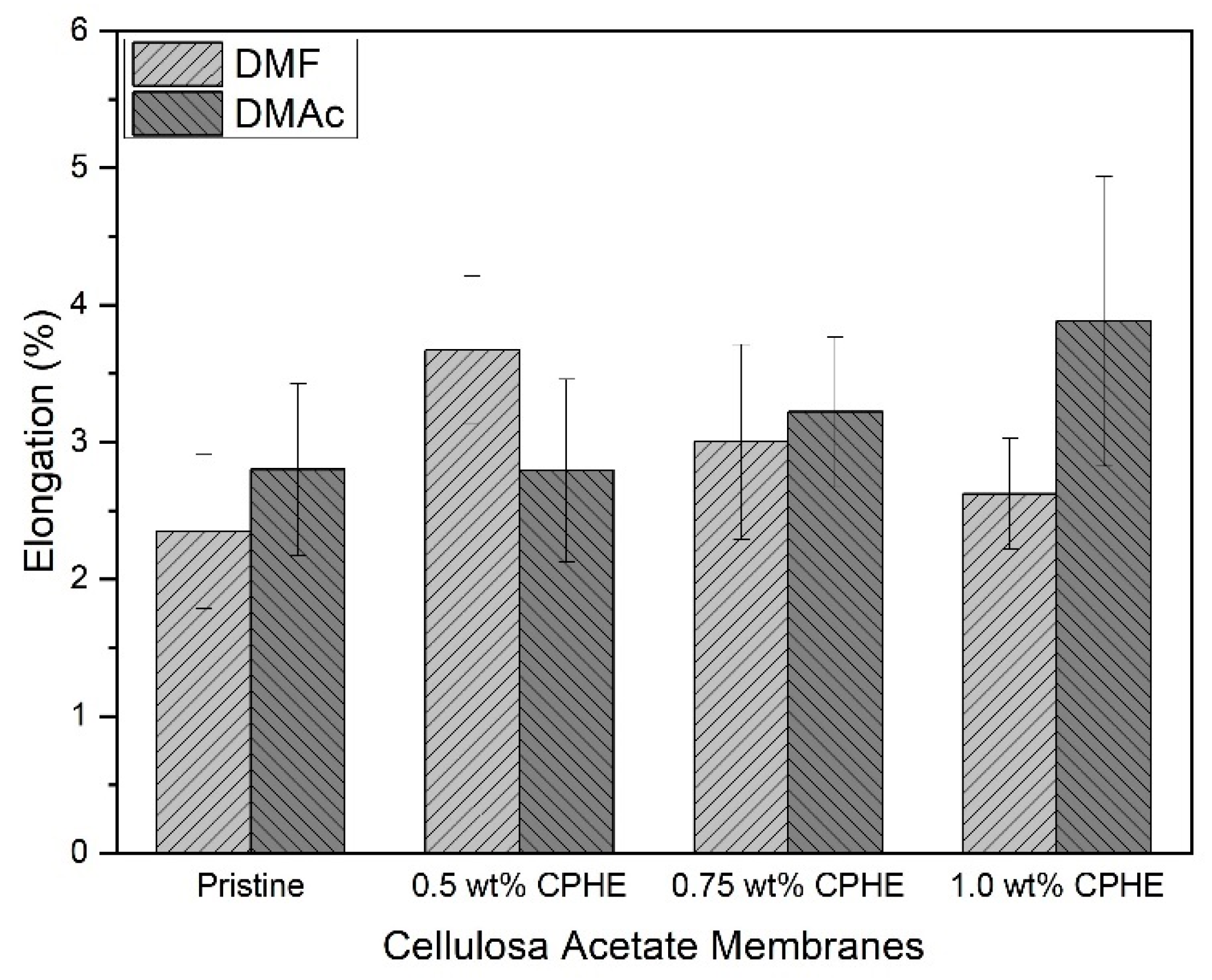
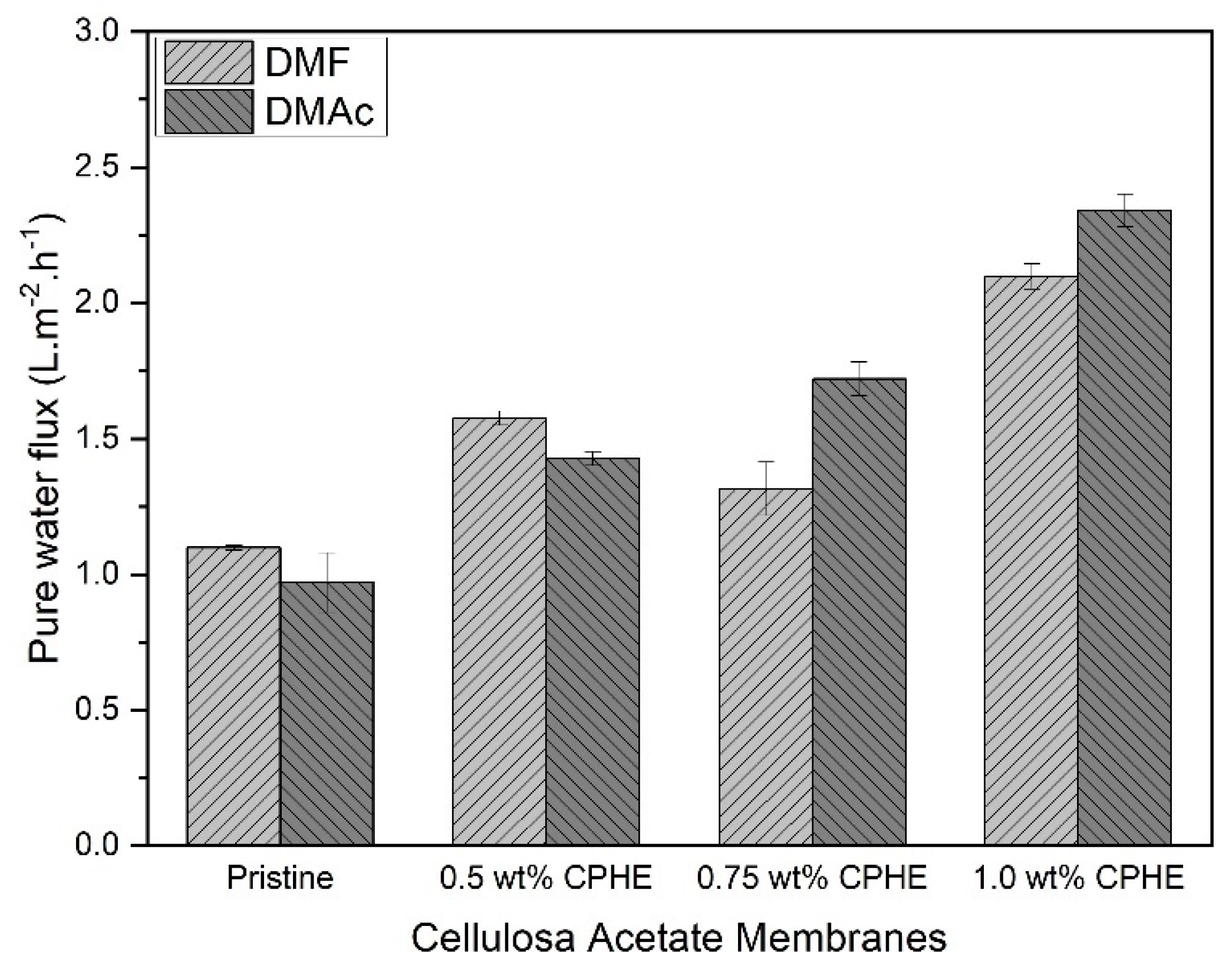
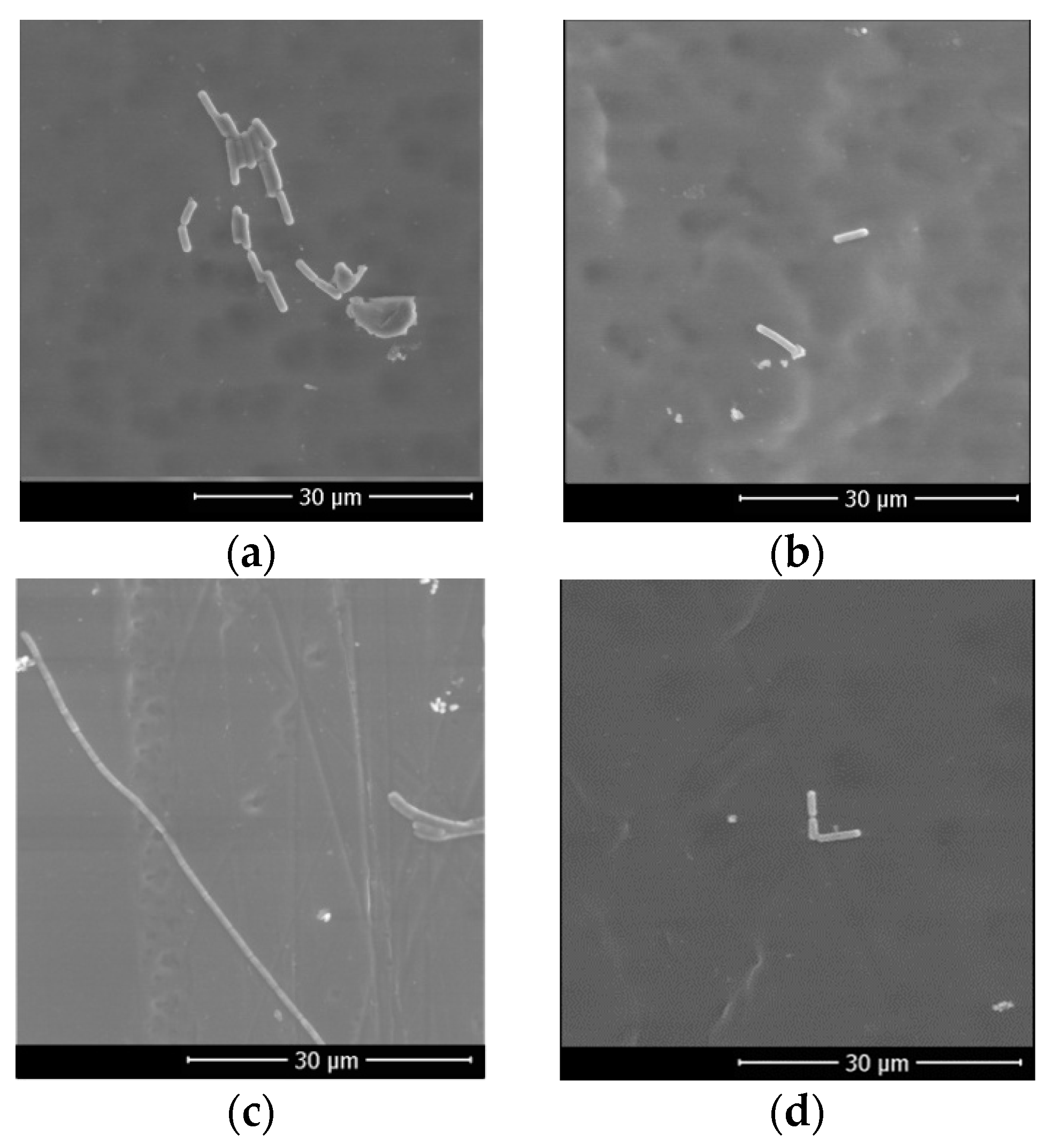

| Membrane Formation | Solvent | CA (g) | CPHE (g) | DMF (mL) | DMAc (mL) |
|---|---|---|---|---|---|
| Pristine CA | DMF | 4 | - | 20 | |
| CA + 0.5 wt% CPHE | DMF | 3.98 | 0.02 | 20 | |
| CA + 0.75 wt% CPHE | DMF | 3.97 | 0.03 | 20 | |
| CA + 1.0 wt% CPHE | DMF | 3.96 | 0.04 | 20 | |
| Pristine CA | DMAc | 4 | - | 20 | |
| CA + 0.5 wt% CPHE | DMAc | 3.98 | 0.02 | 20 | |
| CA + 0.75 wt% CPHE | DMAc | 3.97 | 0.03 | 20 | |
| CA + 1.0 wt% CPHE | DMAc | 3.96 | 0.04 | 20 |
Publisher’s Note: MDPI stays neutral with regard to jurisdictional claims in published maps and institutional affiliations. |
© 2021 by the authors. Licensee MDPI, Basel, Switzerland. This article is an open access article distributed under the terms and conditions of the Creative Commons Attribution (CC BY) license (https://creativecommons.org/licenses/by/4.0/).
Share and Cite
Wibisono, Y.; Diniardi, E.M.; Alvianto, D.; Argo, B.D.; Hermanto, M.B.; Dewi, S.R.; Izza, N.; Putranto, A.W.; Saiful, S. Cacao Pod Husk Extract Phenolic Nanopowder-Impregnated Cellulose Acetate Matrix for Biofouling Control in Membranes. Membranes 2021, 11, 748. https://doi.org/10.3390/membranes11100748
Wibisono Y, Diniardi EM, Alvianto D, Argo BD, Hermanto MB, Dewi SR, Izza N, Putranto AW, Saiful S. Cacao Pod Husk Extract Phenolic Nanopowder-Impregnated Cellulose Acetate Matrix for Biofouling Control in Membranes. Membranes. 2021; 11(10):748. https://doi.org/10.3390/membranes11100748
Chicago/Turabian StyleWibisono, Yusuf, Eka Mustika Diniardi, Dikianur Alvianto, Bambang Dwi Argo, Mochamad Bagus Hermanto, Shinta Rosalia Dewi, Nimatul Izza, Angky Wahyu Putranto, and Saiful Saiful. 2021. "Cacao Pod Husk Extract Phenolic Nanopowder-Impregnated Cellulose Acetate Matrix for Biofouling Control in Membranes" Membranes 11, no. 10: 748. https://doi.org/10.3390/membranes11100748









